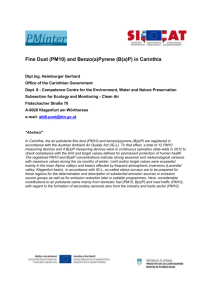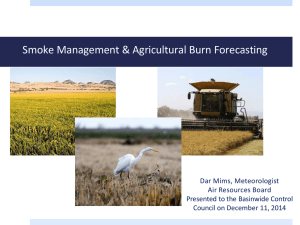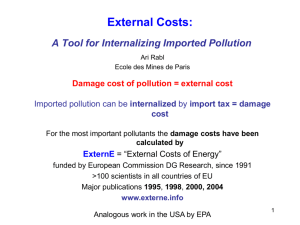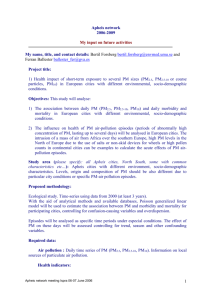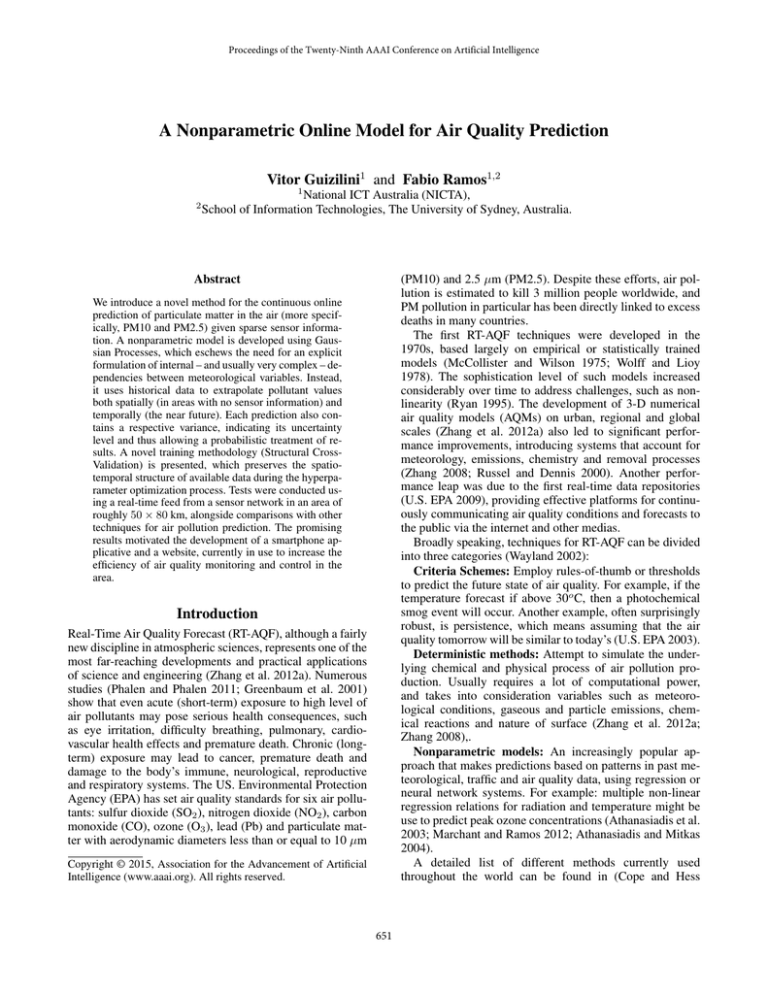
Proceedings of the Twenty-Ninth AAAI Conference on Artificial Intelligence
A Nonparametric Online Model for Air Quality Prediction
Vitor Guizilini1 and Fabio Ramos1,2
1
2
National ICT Australia (NICTA),
School of Information Technologies, The University of Sydney, Australia.
(PM10) and 2.5 μm (PM2.5). Despite these efforts, air pollution is estimated to kill 3 million people worldwide, and
PM pollution in particular has been directly linked to excess
deaths in many countries.
The first RT-AQF techniques were developed in the
1970s, based largely on empirical or statistically trained
models (McCollister and Wilson 1975; Wolff and Lioy
1978). The sophistication level of such models increased
considerably over time to address challenges, such as nonlinearity (Ryan 1995). The development of 3-D numerical
air quality models (AQMs) on urban, regional and global
scales (Zhang et al. 2012a) also led to significant performance improvements, introducing systems that account for
meteorology, emissions, chemistry and removal processes
(Zhang 2008; Russel and Dennis 2000). Another performance leap was due to the first real-time data repositories
(U.S. EPA 2009), providing effective platforms for continuously communicating air quality conditions and forecasts to
the public via the internet and other medias.
Broadly speaking, techniques for RT-AQF can be divided
into three categories (Wayland 2002):
Criteria Schemes: Employ rules-of-thumb or thresholds
to predict the future state of air quality. For example, if the
temperature forecast if above 30o C, then a photochemical
smog event will occur. Another example, often surprisingly
robust, is persistence, which means assuming that the air
quality tomorrow will be similar to today’s (U.S. EPA 2003).
Deterministic methods: Attempt to simulate the underlying chemical and physical process of air pollution production. Usually requires a lot of computational power,
and takes into consideration variables such as meteorological conditions, gaseous and particle emissions, chemical reactions and nature of surface (Zhang et al. 2012a;
Zhang 2008),.
Nonparametric models: An increasingly popular approach that makes predictions based on patterns in past meteorological, traffic and air quality data, using regression or
neural network systems. For example: multiple non-linear
regression relations for radiation and temperature might be
use to predict peak ozone concentrations (Athanasiadis et al.
2003; Marchant and Ramos 2012; Athanasiadis and Mitkas
2004).
A detailed list of different methods currently used
throughout the world can be found in (Cope and Hess
Abstract
We introduce a novel method for the continuous online
prediction of particulate matter in the air (more specifically, PM10 and PM2.5) given sparse sensor information. A nonparametric model is developed using Gaussian Processes, which eschews the need for an explicit
formulation of internal – and usually very complex – dependencies between meteorological variables. Instead,
it uses historical data to extrapolate pollutant values
both spatially (in areas with no sensor information) and
temporally (the near future). Each prediction also contains a respective variance, indicating its uncertainty
level and thus allowing a probabilistic treatment of results. A novel training methodology (Structural CrossValidation) is presented, which preserves the spatiotemporal structure of available data during the hyperparameter optimization process. Tests were conducted using a real-time feed from a sensor network in an area of
roughly 50 × 80 km, alongside comparisons with other
techniques for air pollution prediction. The promising
results motivated the development of a smartphone applicative and a website, currently in use to increase the
efficiency of air quality monitoring and control in the
area.
Introduction
Real-Time Air Quality Forecast (RT-AQF), although a fairly
new discipline in atmospheric sciences, represents one of the
most far-reaching developments and practical applications
of science and engineering (Zhang et al. 2012a). Numerous
studies (Phalen and Phalen 2011; Greenbaum et al. 2001)
show that even acute (short-term) exposure to high level of
air pollutants may pose serious health consequences, such
as eye irritation, difficulty breathing, pulmonary, cardiovascular health effects and premature death. Chronic (longterm) exposure may lead to cancer, premature death and
damage to the body’s immune, neurological, reproductive
and respiratory systems. The US. Environmental Protection
Agency (EPA) has set air quality standards for six air pollutants: sulfur dioxide (SO2 ), nitrogen dioxide (NO2 ), carbon
monoxide (CO), ozone (O3 ), lead (Pb) and particulate matter with aerodynamic diameters less than or equal to 10 μm
Copyright © 2015, Association for the Advancement of Artificial
Intelligence (www.aaai.org). All rights reserved.
651
2005). Current state-of-the-art (Zhang et al. 2012b) include
3-D online-coupled meteorology-chemistry models, based
on global and regional CTMs (Chemical Transport Models)
that enable a better understanding of mechanisms for pollutant formation and development of emission control strategies. Extension to these models include their coupling with
urban models (traffic and/or local pollutant dispersion) or a
CFD model for urban/local scale applications.
The deterministic approaches rely on parametric models that must be carefully constructed by experts according to which phenomenon is being studied. A balance must
be reached between complexity and computational power,
which imposes a limit to how many variables can be incorporated, as well as their mutual correlations. This work takes
a different approach and looks into RT-AQF from a machine learning perspective, with historically accurate measurements being used to extrapolate the value of a target
variable (particulate matter concentration) both in time (the
near future) and space (where there are no sensor measurements). In fact, this approach is particularly useful in such
problems due to their chaotic nature: the number of contributing factors is so high that no deterministic model will
ever be able to capture all its nuances, and even minor imprecisions on initial conditions will produce vastly different
outcomes.
Commonly used methods include classification and regression trees (Burrows et al. 1995), artificial neural networks (Perez and Reyes 2006), fuzzy logic (Shad et al. 2009)
and variations of the Kalman Filter (van der Wal and Janssen
2000; Zolghadri and Cazaurang 2006). This paper introduces the use of Gaussian processes as a machine learning
tool for air quality forecast, and develops a novel framework
for the training and continuous update of the nonparametric
model over spatio-temporal data. This framework is able to
learn periodical patterns in previous measurements in order
to probabilistically predict their values in unobserved areas
of the input space, as well as gradually adapt to new behaviors as more information is incorporated into the starting
model. A novel training methodology is proposed, named
Structural Cross-Validation, that is shown to improve accuracy by minimizing an error function while maintaining the
spatio-temporal structure of available data. We also explore
the use of other environmental variables, such as temperature, humidity and wind, to improve the accuracy of PM10
and PM2.5 predictions.
function between inputs and outputs. This approach eliminates the need to explicitly define a model, using instead
previous measurements to extract patterns and then extrapolate this information to new, unobserved areas of the input
space. This allows for greater flexibility and generality, and
we show how to maintain computational complexity under
check while achieving a good approximation of the underlying function.
Inference
We start with a set of N observations y = {yn }N
n=1 and its
corresponding spatio-temporal coordinates X = {xn }N
n=1 ,
where xn = {x, y, t}n contains latitude, longitude and time
components. The goal is to estimate a continuous transformation function f (xn ) between inputs and outputs, thus allowing inference to be performed in unknown regions of the
input space. The closer these regions are to the available
data, the more accurate the final estimation will be, as it is
to be expected.
This proximity is defined by a covariance function
k(xi , xj ), or kernel, which imposes a metric that quantifies
how close any two input points are to each other. From this
covariance function the covariance matrix K is generated,
with components Kij = k(xi , xj ). Inference on a test point
x∗ is then of the form:
−1
f¯∗ = m(x∗ ) + K∗N K̃N
N (y − m(X))
v∗ = K∗∗ −
−1
K∗N K̃N
N KN ∗ ,
(1)
(2)
where K̃N N = KN N + σn2 I is the covariance matrix KN N
disturbed by zero-mean Gaussian noise of variance σn2 and
m(.) is a mean function selected as part of the nonparametric model. The covariance function parameters θk , the mean
function parameters θm and the noise level σn , compose
the hyperparameter set θ = (θk , θm , σn ) that defines the
GP model. These values can be optimized based on available data by maximizing a certain objective function, usually the log-marginal likelihood (Rasmussen and Williams
2006) due to its balance between complexity and data fit that
avoids overfitting.
Covariance Functions
As stated previously, the choice of covariance function plays
a pivotal role in the predictive power of a nonparametric
model. For the particular case of air pollutant prediction (or
any environmental phenomenon), we are particularly interested in temporal trends, that repeat over time in a cyclical
manner. For this reason, two different covariance functions
were selected, the Matérn 3/2 (Eq. 3) and the Periodic (Eq.
4), the first to account for short and medium-term trends and
the second to account for cyclical patterns:
√ √ 3r
3r
kM T = θv2 1 + 2
exp − 2
,
(3)
θl
θl
⎞
⎛
−2 sin2 θrp
⎠.
kP R = θv2 exp ⎝
(4)
θl2
Overview on Gaussian Processes
The task of estimating air pollutant values from historical
data can be seen as a regression problem, where available information is extrapolated to areas of the input space with no
direct measurements. While most current approaches use a
carefully developed model involving different relevant variables and their correlations, there is a limit to how many
variables can be used, and a limit to how complex these correlations can become before the resulting model is rendered
computationally unfeasible.
We opted here to go in a different direction and use a
nonparametric model, in particular a Gaussian Process (Rasmussen and Williams 2006), to generate the transformation
652
500
1000
1500
2000
2500
3000
500
1000
1500
2000
2500
3000
Figure 1: Example of the covariance matrix K, based on Eq.
5. The diagonal area is more closely related, due to the temporal Matérn covariance function, and the various waves indicate different periodic cycles, that gradually lose strength
due to decay. The chess pattern is due to spatial correlation,
that distantiates points that are physically far away.
Figure 2: Frequency analysis on hourly measurement of air
pollutant concentrations. Starting from the top left, each image incorporates a new frequency into the estimate (blue
line), and it is possible to see how the resulting approximation (red line) starts to resemble the true signal (black line).
In the above equations, r = |xi − xj | is the distance between
input points and the various θ parameters compose the covariance function coefficients θk that will be optimized during the training stage. The final spatio-temporal covariance
function (Fig. 1) is then of the form:
xy
xy
t
k = kM
T + kM T × kM T +
P
p=1
t(p)
t
kM
T kP R .
Sub-sampling
A common drawback in the standard GP derivation (as
in most machine learning algorithms) is the computational
cost, that scales cubically with the number of training points.
This imposes a limit to the amount of available data that can
be maintained for training and inference purposes, which is
especially detrimental to this application due to the presence
of periodic functions that could in theory go back months or
even years in time.
For this reason, a novel sub-sampling method is proposed,
which exploits the cyclical nature of periodic covariance
functions to remove data that will be less correlated to the
test points (Fig. 3). This can be achieved by setting up a
threshold level δ for the correlation value that is deemed relevant, and discarding all points that fall below this threshold:
N
t(p)
t(p)
.
(6)
{X, y}P R = (x, y)n | kP R (xn , x∗ ) > δ
(5)
We can see that the spatial and temporal components of
the covariance function are calculated separately and multiplied at the end. Spatially, two Matérns account for short
and medium-scale behavioral changes in air pollutant concentration, while temporally there is one Matérn for shortterm trends and a series of Periodics to model cyclical patterns. Each Periodic, in turn, is multiplied by a Matérn to
account for decay, where the effects of old behaviors slowly
fade away as the time interval increases.
Frequency Analysis
Every signal, no matter its complexity, is composed of basic
waves, and as more waves are used to represent it, the closer
the approximation becomes to the original. However, it is
impossible to use all frequencies to describe a signal, and
therefore it is necessary to select which ones are more relevant to the application at hand. Also, while the GP framework is capable of learning specific frequency parameters
(the θp in Eq. 4), it is vital that a good initial estimate is provided due to the presence of local maxima in the objective
function.
For this reason, a frequency analysis (Terras 2011) is first
conducted on the available data to find its wave components
in descending order of relevance (Fig. 2). The first P components are used as starting values for the periodic hyperparameters, and further optimized during the training stage.
The upper limit for the number of frequencies used by the
nonparametric model is given by the increase in hyperparameter quantity, that affects training times and may create
overfitting scenarios.
n=1
Since the periodic hyperparameters are known (albeit
changing during the training stage), they can be used to determine these intervals without the need to calculate every
correlation. The resulting subset can then be efficiently obtained by means of simple comparisons between the temporal components:
N
M
t(p)
{X, y}P R =
(x, y)n | ∪ d(t∗ − pi, tn ) < θl h(p)
i=1
n=1
, (7)
where d(x, y) = |x − y|, M is the number of historical periods to be considered and h(p) is the interval of hours considered, which is √
itself a function of p (empirically we determined h(p) = p to be a suitable interval function). This
process is repeated for each periodic covariance function,
P
t(p)
generating the subset {X, y}tP R = ∪ {X, y}P R that is
p=1
653
is restored to normal levels once new information becomes
available.
For the training stage, each estimate also contains its respective ground-truth, which allows for a third step:
3. Error Calculation: The estimate set is compared to their
respective ground-truths, according to an error metric
e(., .), and a measure of accuracy ζ is produced:
ζ k = e(f∗k+h , yk+h ).
Figure 3: Example of subsampling, for a periodic covariance
function with a period θp = 24 hours and length-scale θl =
0.5. With this configuration, only roughly 30% of the points
are used during training and inference.
(10)
A diagram of the proposed Structural Cross-Validation algorithm is depicted in Fig. 4. Initially, the available data is
divided into two subsets: starting model {X, y}1:S and evaluation data {X, y}S+1:N . Each training step is performed
by incrementally (1) incorporating evaluation data from the
current timestep into the starting model; (2) performing inference on evaluation data from h timesteps ahead; and (3)
comparing these estimates to the actual measurements to
N
ζk
generate error values. The accumulated error ζ =
most correlated to the test points given the necessary computational constraints. This method is particularly useful with
longer periods and smaller length-scales, since this configuration tends to create sharp peaks with larger areas of virtually no correlation.
k=S+1
quantifies the adequacy of the current nonparametric model,
and is minimized using standard gradient-descend techniques.
Note that, while the final model can be used to perform
inference at any spatio-temporal coordinate, it will be optimized for the timestep h used during training. This allows
the generation of specific models for different timesteps, that
will provide better estimates than a generic one. The same
training process can be maintained during the inference
stage, taking advantage of the interval between timesteps to
further optimize the hyperparameters based on new information. This allows the nonparametric model to gradually adapt
to new behaviors and forget old ones, a vital characteristic
for long-term usability.
Training Methodology
The aforementioned sub-sampling method, while effective
in decreasing the amount of data used for inference, has the
drawback of being sensitive to the test point coordinates,
since correlation is calculated in relation to that particular timestep. For this reason, we propose a novel training
methodology that not only exploits this behavior to produce
models optimized for different future predictions, but also
maintains during training the same spatio-temporal structure
available for inference. We also propose a technique to incorporate extra environmental variables into the prediction
of air pollutant concentrations, by combining individually
trained base models.
Structural Cross-Validation
Extra Variables
The proposed training methodology resembles the traditional Cross-Validation (CV) approach, in the sense that
an error function between ground-truth and estimates is
minimized. However, this minimization is conducted while
maintaining the same spatio-temporal structure that will be
available during inference. We start from the design assumption that, during the inference stage, at each timestep k two
actions are performed:
1. Update: New available measurements are incorporated
into the nonparametric model:
(8)
{X, y}1:k = {X, y}1:k−1 , {X, y}k
Here another issue is explored: the incorporation of extra
variables into the nonparametric model for the prediction of
air pollutant concentrations. Several environmental factors,
such as temperature, humidity and wind, may be responsible for changes in air pollutant concentrations, and therefore
could be used to improve estimates. A straightforward approach would be the use of multiple-output GPs (Boyle and
Frean 2005), but this would create an even bigger computational cost, due to the need of simultaneously maintain all
variables and their correlations.
2. Prediction: A new estimate set is obtained for h
timesteps into the future (Eqs. 1 and 2):
|{X, y}1:k , θk ).
f∗k+h = GP(xk+h
∗
(9)
By constantly adding new information to the nonparametric model, we ensure that predictions will always be at a
fixed distance h from available data, and thus will have similar variance values. Gaps in data (such as sensor failure)
are treated naturally by an increase in variance values, that
Figure 4: Diagram of the Structural Cross-Validation technique.
654
(a) PM10 / 01h
(b) PM10 / 24h
(c) PM2.5 / 01h
(d) PM2.5 / 24h
Figure 5: Diagram of the framework for incorporating extra
variables.
Because of that, we propose a layered model that combines different base models to increase the amount of information available for inference, without significantly affecting computational time and memory requirements. A
diagram of this layered model is depicted in Fig. 5, for
the particular case of using PM10, humidity, temperature
and wind to predict PM2.5 concentrations. Each one of
these extra variables receives the measurements coordinates
x = {x, y, t} and their respective ground-truth to produce
its own base model. The predictions from these base models are used to augment the input vector for the combined
model, which is then trained based on its own ground-truth
information. During inference, further optimization can be
performed individually for each base model, and afterwards
the new estimates are used to further optimize the combined
model.
Figure 7: Performance improvement given by the incorporation of extra variables, according to the error metric used
during optimization (average over 1 month period).
sensors also provide hourly PM2.5 measurements. The goal
was to generate predictive estimates for 1 and 24 hours into
the future, as well as in the area surrounding the sensors. In
all experiments, a time interval of 3 months was used for
training (2 for the starting model and 1 for evaluation), with
initial periods of 24, 48, 168 and 672 hours. As new data
is incorporated, old data is removed at the same rate. Priority was given to sudden increases in pollutant concentration,
since these are the relevant behaviors in air quality control.
It is worthy noting that RT-AQF models notoriously struggle
with hourly and daily estimates, usually performing better in
larger time-scales.
A different base model was trained based on each of these
variables, and then combined to generate the final models for
PM10 and PM2.5 (PM10 measurements were also used to
improve PM2.5 estimates). The improvement generated by
the incorporation of each extra variables can be seen in Fig.
7, as well as the improvement generated by the inclusion of
all of them. We can see that, for PM10, adding temperature
produced the largest improvement, while for PM2.5 it was
the introduction of PM10 estimates, followed by humidity.
In all cases, the combined model was capable of greatly improving performance, roughly doubling accuracy by maintaining base models of extra variables.
Another way of quantifying the improvement proportioned by the incorporation of extra variables is with QQplots; a graphical method for comparing two probability
distributions, by plotting their quantiles against each other.
If the two distributions are linearly related, the points in
the QQ-plot will approximately lie on a line, and any nonlinearity will generate deviations. The QQ-plots for base and
combined models are shown in Fig. 8, where we can see that
the introduction of extra variables is indeed capable of approximating the prediction and measurement distributions.
As expected, the algorithm performs less accurately in areas
of high pollution value, since these are sporadic and the nonparametric model does not have enough samples for a robust
Experimental Results
Tests were conducted using a sensor network composed of
14 sensors, covering an area of roughly 50 × 80 km. All
sensors provide hourly measurements of PM10, temperature
(TP), humidity (HM) and wind (WD), and three of these
Figure 6: Sensor network used during experiments.
655
(a) PM10 / 01h
(b) PM10 / 24h
(c) PM2.5 / 01h
(d) PM2.5 / 24h
Figure 9: Comparison between GP estimates (red line) and actual sensor measurements (black line), within two standard deviations (blue lines) over the course of 1 month.
Poll. / # hours
PM10 / 1h
PM10 / 24h
PM2.5 / 1h
PM2.5 / 24h
estimate. A quantitative comparison between these results
and other approaches is given in Table 1.
The progression of predictions over time, for each sensor,
can be seen in Fig. 9, alongside the actual measurements and
the corresponding 95% confidence boundaries. As expected,
1 hour predictions are very accurate, and this performance
decreases as we move away from test data. Note that the estimates are still within the confidence boundaries, indicating
(a) PM10 / 24h (base)
SCV-GP
8.48
13.21
3.92
5.05
PERS
14.67
22.09
6.89
11.93
FITC
10.42
18.29
5.11
9.98
CART
9.91
17.27
4.83
9.11
Table 1: Root Mean Square Error comparison between the
proposed algorithm (SCV-GP) and the persistent approach
(PERS), a sparse GP implementation (FITC, (Quinonerocandela, Ramussen, and Williams 2007)) and decision trees
(CART, (Breiman et al. 1984)). The same extra variables
were used in all experiments (where applicable).
that the nonparametric model is able to correctly gauge the
accuracy of its own predictions. These estimates can then be
used to prevent high peaks in air pollutant concentrations by
taking cautionary measures in areas of highest probability of
reaching hazardous thresholds.
(b) PM10 / 24h (combined)
Conclusion
(c) PM2.5 / 24h (base)
We presented a novel algorithm for the online prediction
of air particulate matter (PM10 and PM2.5) that relies on
a nonparametric model to extract patterns from historical
data and uses this information to estimate future behaviors,
both spatially and temporally. This is a purely nonparametric
approach, without any assumptions regarding the physical
and chemical aspects of air pollution, and therefore could be
(d) PM2.5 / 24h (combined)
Figure 8: QQ-Plots for PM10 and PM2.5.
656
readily applied to any spatio-temporal predictive scenario. It
scales linearly to the number of extra variables, and is able
to incorporate new information as it becomes available. The
probabilistic nature of GPs allows the generation of uncertainty values alongside the estimates in an intuitive manner
that can be easily understood by the final user. In future work
we intend to explore the use of mobile sensors, as a way
to maximize coverage without the need to increase the network size. More powerful modeling techniques will also be
explored, such as nonstationarity and heteroscedasticity.
Phalen, R., and Phalen, R. 2011. Introduction to Air Pollution Science. Jones and Bartlett Learning.
Quinonero-candela, J.; Ramussen, C. E.; and Williams, C.
K. I. 2007. Approximation methods for gaussian process
regression.
Rasmussen, C. E., and Williams, K. I. 2006. Gaussian Processes for Machine Learning. The MIT Press.
Russel, A., and Dennis, R. 2000. Narsto critical review of
photochemical models and modeling. Atmospheric Environment 34:2283–2324.
Ryan, W. F. 1995. Forecasting ozone episodes in the
baltimore metropolitan area. Atmospheric Environment
29:2387–2398.
Shad, R.; Mesgari, M. S.; abkar, A.; and Shad, A. 2009. Predicting air pollution using fuzzy genetic linear membership
kriging in GIS. Computers, Environment and Urban Systems
33(6):472 – 481.
Terras, A. 2011. Fourier analysis on finite groups and applications. Cambridge University Press.
U.S. EPA. 2003. Technical assistance document for reporting of daily air quality - air quality index (AQI). Technical report, Environmental Protection Agency, Office of Air
Quality Planning and Standards, Research Triangle Park,
NC.
U.S. EPA. 2009. Technical assistance document for reporting of daily air quality - air quality index (AQI). Technical report, Environmental Protection Agency, Office of Air
Quality Planning and Standards, Research Triangle Park,
NC.
van der Wal, J., and Janssen, L. 2000. Analysis of spatial and temporal variations of PM 10 concentrations in the
netherlands using kalman filtering. Atmospheric Environment 34(22):3675 – 3687.
Wayland, R. 2002. Communicating real-time and forecasted
air quality to the public. Environment Management.
Wolff, G. T., and Lioy, P. J. 1978. An empirical model for
forecasting maximum daily ozone levels in the northeastern
united states. Journal of Air Pollution Control Association
28:1034–1038.
Zhang, Y.; Bocquet, M.; Mallet, V.; Seigneur, C.; and Baklanov, A. 2012a. Real-time air quality forecasting, part i:
History, techniques, and current status. Atmospheric Environment 60:632–655.
Zhang, Y.; Bocquet, M.; Mallet, V.; Seigneur, C.; and Baklanov, A. 2012b. Real-time air quality forecasting, part
ii: State of the science, current research needs, and future
prospects. Atmospheric Environment 60:656–676.
Zhang, Y. 2008. Online coupled meteorology and chemistry
models: History, current status, and outlook. Atmospheric
Chemistry and Physics Discussions 8:1833–1912.
Zolghadri, A., and Cazaurang, F. 2006. Adaptive nonlinear state-space modelling for the prediction of daily mean
PM10 concentrations. Environmental Modelling and Software 21(6):885 – 894.
Acknowledgements
NICTA is funded by the Australian Government through
the Department of Communications and the Australian Research Council through the ICT Centre of Excellence Program.
References
Athanasiadis, I. N., and Mitkas, P. A. 2004. An agent-based
intelligent environmental monitoring system. CoRR.
Athanasiadis, I. N.; Kaburlasos, V. G.; Mitkas, P. A.; and
Petridis, V. 2003. Applying machine learning techniques on
air quality data for real-time decision support. In In: First International NAISO Symposium on Information Technologies
in Environmental Engineering (ITEE’2003, 24–27. ICSCNAISO Publishers.
Boyle, P., and Frean, M. 2005. Multiple output gaussian
process regression. Technical report, University of Wellington.
Breiman, L.; Friedman, J.; Olshen, R.; and Stone, C.
1984. Classification and Regression Trees. Monterey, CA:
Wadsworth and Brooks.
Burrows, W. R.; Benjamin, M.; Beauchamp, S.; Lord, E. R.;
McCollor, D.; and Thomson, B. 1995. CART Decision-Tree
Statistical Analysis and Prediction of Summer Season Maximum Surface Ozone for the Vancouver, Montreal, and Atlantic Regions of Canada. Journal of Applied Meteorology
34:1848–1862.
Cope, M. E., and Hess, G. D. 2005. Air quality forecasting:
a review and comparison of the approaches used internationally and in australia. Clean Air and Environmental Quality
39:39–45.
Greenbaum, D. S.; Bachmann, J. D.; Krewski, D.; Samet,
J. M.; White, R.; and Wyzga, R. E. 2001. Particulate air
pollution standards and morbidity and mortality: case study.
Americal Journal Epidemiology 154(12 Suppl):S78–90.
Marchant, R., and Ramos, F. 2012. Bayesian optimisation
for intelligent environmental monitoring. In IROS, 2242–
2249. IEEE.
McCollister, G., and Wilson, K. 1975. Linear stochastic
models for forecasting daily maxima and hourly concentrations of air pollutants. Atmospheric Environment 9:417–423.
Perez, P., and Reyes, J. 2006. An integrated neural network model for PM10 forecasting. Atmospheric Environment 40(16):2845 – 2851.
657



